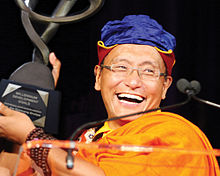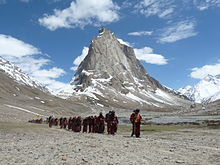
Padmasambhava, also known as Guru Rinpoche, was a semi-legendary tantric Buddhist Vajra master from India who fully revealed the Vajrayana in Tibet, circa 8th – 9th centuries. He is considered an emanation or Nirmāṇakāya of Shakyamuni Buddha as foretold by the Buddha himself. According to early Tibetan sources including the Testament of Ba, he came to Tibet in the 8th century and designed Samye Monastery, the first Buddhist monastery in Tibet during the reign of King Trisong Detsen. He, the king, and Khenpo Shantarakshita are also responsible for creating the Tibetan Canon through translating all of the Buddha's teachings and their commentaries into the Tibetan language.
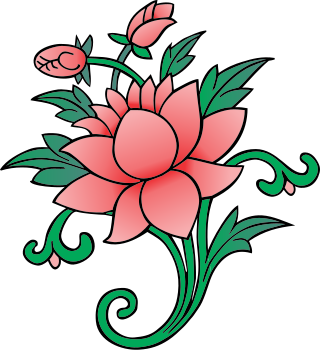
The Drukpa or Drukpa Kagyu lineage, sometimes called Dugpa in older sources, is a branch of the Kagyu school of Tibetan Buddhism. The Kagyu school is one of the Sarma or "New Translation" schools of Tibetan Buddhism. The Drukpa lineage was founded in the Tsang region of Tibet by Tsangpa Gyare (1161–1211), and later became influential in Ladakh and Bhutan. It is one of several lineages known as "Red Hat sects".

Ngawang Namgyal (1594–1651), known colloquially as The Bearded Lama, was a Tibetan Buddhist Drukpa Kagyu school Rinpoche, and the unifier of Bhutan as a nation-state. He was later granted the honorific title Zhabdrung Rinpoche, approximately "at whose feet one submits". In addition to unifying the various warring fiefdoms for the first time in the 1630s, he also sought to create a distinct Bhutanese cultural identity separate from the Tibetan culture from which it was derived.

Drikung Kagyü or Drigung Kagyü is one of the eight "minor" lineages of the Kagyu school of Tibetan Buddhism. "Major" here refers to those Kagyü lineages founded by the immediate disciples of Gampopa (1079-1153), while "minor" refers to all the lineages founded by disciples of Gampopa's main disciple, Phagmo Drupa (1110-1170). One of these disciples, Jigten Sumgön (1143-1217), is the founder of Drikung.
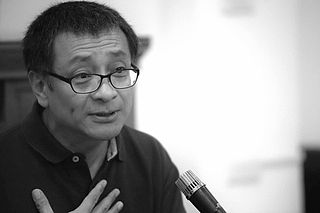
The 7th Dzogchen Ponlop is an abbot of Dzogchen Monastery, founder and spiritual director of Nalandabodhi, founder of Nītārtha Institute for Higher Buddhist Studies, a leading Tibetan Buddhist scholar, and a meditation master. He is one of the highest tülkus in the Nyingma lineage and an accomplished Karma Kagyu lineage holder.

Kyabje Dudjom Rinpoche Jigdral Yeshe Dorje was known simply as Dudjom Rinpoche. He is considered by many Tibetan Buddhists to be from an important Tulku lineage of Terton Dudul Dorje (1615–1672), and was recognized as the incarnation of Terton Dudjom Lingpa (1835–1904), a renowned treasure revealer. He was a direct incarnation of both Padmasambhava and Dudjom Lingpa. He was a Nyingma householder, a yogi, and a Vajrayana and Dzogchen master. According to his secretary Khenpo Tsewang Dongyal and many others, he was revered as "His Holiness" (Kyabje) and as a "Master of Masters".

Ayu Khandro, also known as Dorje Paldrön, was a Tibetan yogini, practitioner and terton of Tantric Buddhism in Eastern Tibet. An accomplished Dzogchen meditator, she is known for her extensive pilgrimages throughout Tibet, long periods of dark retreat practice, the gongter of the practice of the yidam Senge Dongma, various forms of Chöd, and her lifelong dedication to spiritual practice.

Rewalsar or Tso Pema in Tibetan is a small town and a pilgrimage place in a nagar panchayat in Mandi district in India. It is located in the state of Himachal Pradesh. The local name for Rewalsar is Tri Sangam. Rewalsar Lake is a tourist spot in the area.
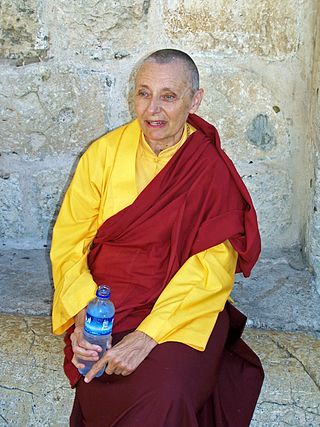
Jetsunma Tenzin Palmo is a bhikṣuṇī in the Drukpa lineage of the Kagyu school of Tibetan Buddhism. She is an author, teacher and founder of the Dongyu Gatsal Ling Nunnery in Himachal Pradesh, India. She is best known for being one of the very few Western yoginis trained in the East, having spent twelve years living in a remote cave in the Himalayas, three of those years in strict meditation retreat.
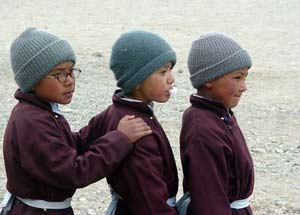
The Druk White Lotus School is located in Shey, Ladakh, in northern India, and is known locally as the Druk Padma Karpo School. Karpo means White and Padma means Lotus in the local language Bodhi.

The Gyalwang Drukpa is the honorific title of the head of the Drukpa Kagyu lineage, one of the independent Sarma (new) schools of Vajrayana Buddhism. This lineage of reincarnated masters started from Tsangpa Gyare, the first Gyalwang Drukpa and founder of the school. The 12th Gyalwang Drukpa, Jigme Pema Wangchen, is the current lineage holder. He was born at Lake Rewalsar, India in 1963.

Kunkhyen Pema Karpo was the fourth Gyalwang Drukpa, head of the Drukpa lineage of Tibetan Buddhism. He was the most famous and learned of all the Gyalwang Drukpas. During his lifetime, he was known as the grand lama amongst all grand lamas, and was a teacher to many lamas and disciples all over Tibet.

Chagri Dorjeden Monastery, also called Cheri Monastery, is a Buddhist monastery in Bhutan established in 1620 by Ngawang Namgyal, 1st Zhabdrung Rinpoche, the founder of the Bhutanese state.
The Khamtrul tulku lineage is part of the Dongyud Palden section of the Drukpa Lineage of the Kagyu school of Tibetan Buddhism.
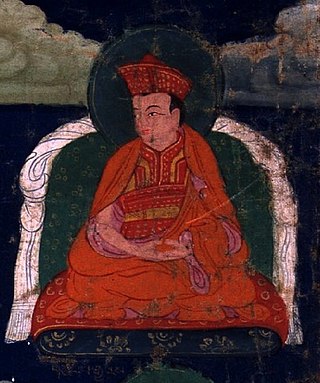
The great ascetic Drogon Tsangpa Gyare (1161–1211) was the main disciple of Lingchen Repa Pema Dorje and the founder of the Drukpa Lineage of Tibetan Buddhism the main or central branch of which was, until the 17th century, transmitted by his hereditary family lineage at Ralung in the Tsang region of Tibet. Later, following the birth of Gyalwang Je Kunga Paljor (1428–1476) considered to be the first of his re-incarnations, Tsangpa Gyare was held to be the first of a succession of Gyalwang Drukpa or Drukchen incarnations who, at the time of the fifth Gyalwang Drukpa Pagsam Wangpo (1593—1653), became established as the reincarnate leaders of the Drukpa lineage in Tibet.

Paro Taktsang, is a sacred Vajrayana Himalayan Buddhist site located in the cliffside of the upper Paro valley in Bhutan. It is one of thirteen Tiger's Nest caves in historical Tibet in which Padmasambhava practiced and taught Vajrayana.
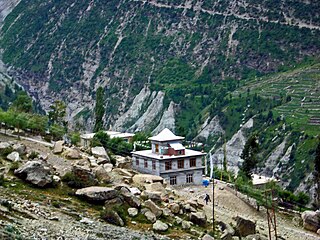
Gondhla is a village located in the Lahaul and Spiti district, Himachal Pradesh, India. It is located about 18 kilometres (11 mi) before Keylong in on the road from Manali, Himachal Pradesh, and lies at 3,160 m (10,370 ft) above sea level. It is located on a hill above Tupchiling Village at the sacred junction of the Chandra and Bhaga rivers, which together form the Chenab River. The village is famous for the Guru Ghantal monastery and the Gondhla fort.
Pema is a Tibetan name meaning "lotus", which originated as a loanword from Sanskrit padma. People who have this name as one of their given names include:
Pagsam Wangpo, a key figure in the history of the Drukpa Lineage of Tibetan Buddhism, was born at Chonggye, in the Tsang province of Tibet a natural son of the prince of Chonggye, Ngawang Sonam Dragpa. He was an elder cousin of the 5th Dalai Lama, Ngawang Lobzang Gyatso (1617-1682).

The Kung Fu Nuns are an order of Buddhist nuns who belong to the Drukpa Kagyu lineage, a thousand-year-old sect led by the Gyalwang Drukpa. Their name comes from the order’s proficiency in Chinese martial arts, which they began learning in 2008 after the 12th Gyalwang Drukpa authorised training for them despite centuries-old Buddhist laws banning exercise for nuns.



